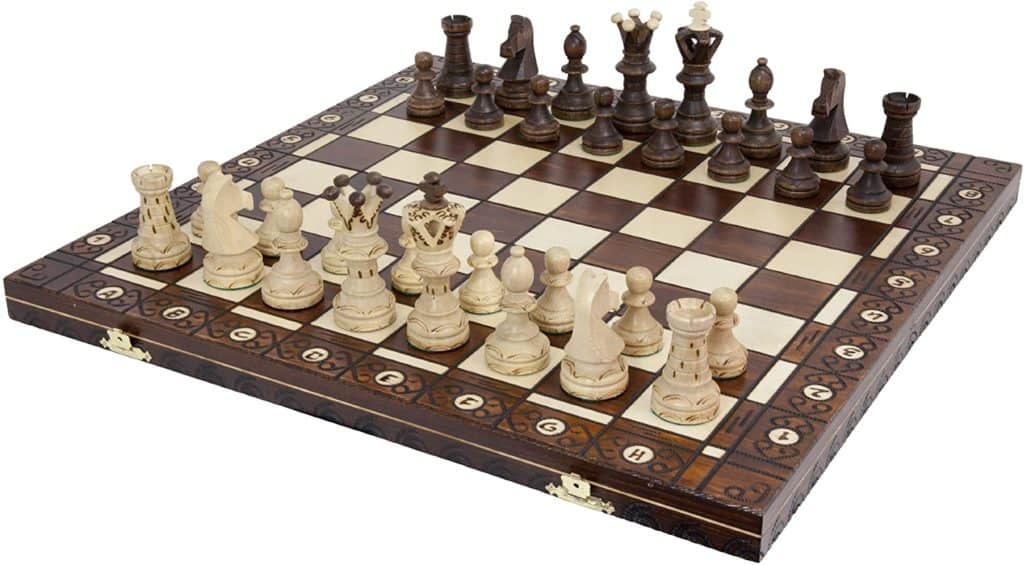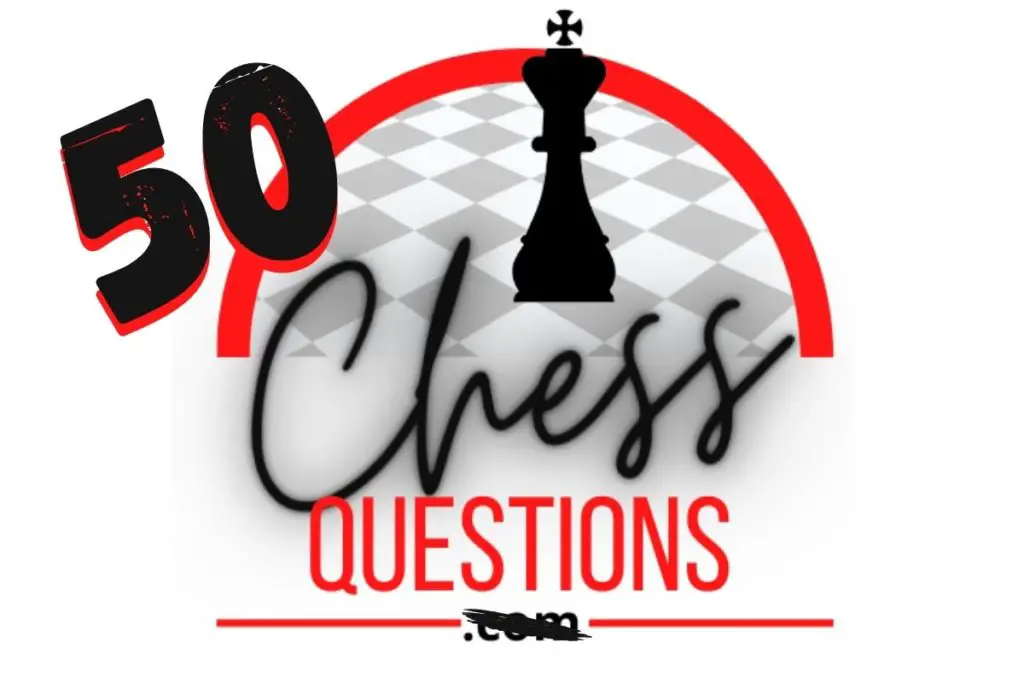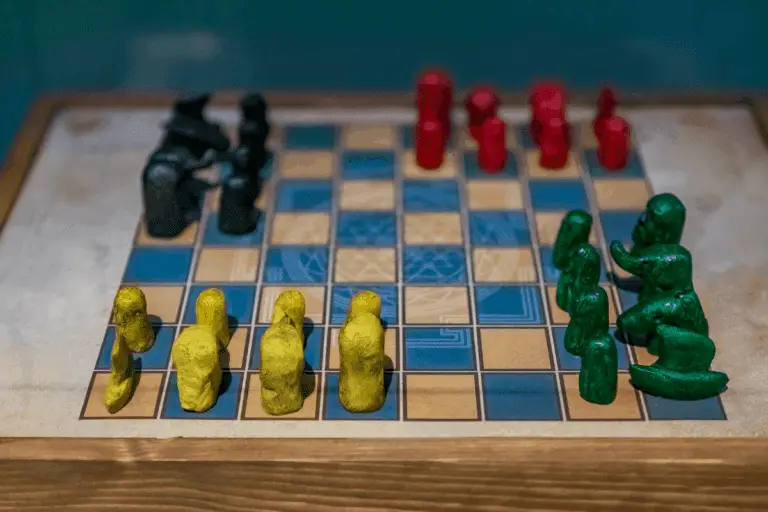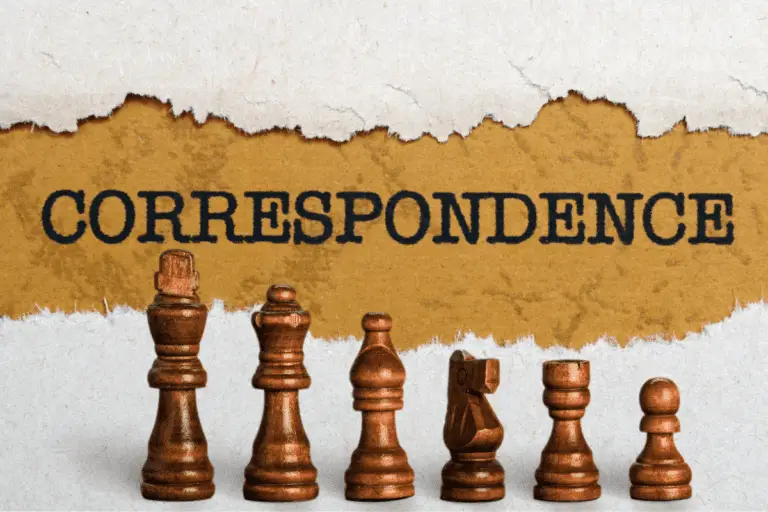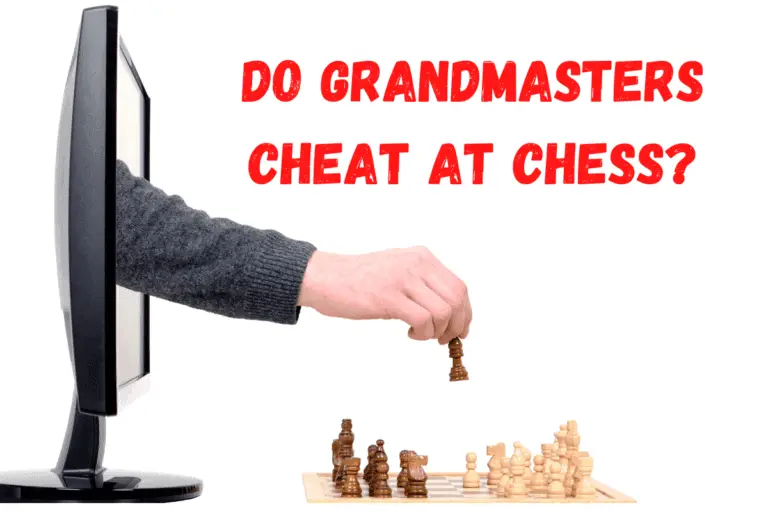All About Chess Pieces (Symbolism, Shape & Design)
⭐⭐⭐ Take 9 minutes to read and improve your chess game ➡️ : This article was first published on, and is Copyright of Chessquestions.com
A game of chess is a battle between two armies. The pieces on the board represent various soldiers and military tactics. Each piece has its own name, meaning, and design.
One set of chess pieces will not be exactly like another because there are many different styles that have developed over time to reflect regional influences or individual preferences. This article discusses the symbolism, shape, and design of chess pieces in order to answer some questions about why they look the way they do and what they represent.
Symbolism in the Design of Chess Pieces
It is reasonable to consider the way a standard set of chess pieces look, that they were designed to represent something. We have the King and Queen who are the most valuable and powerful pieces on the board and they seem relatively straightforward. What does the game of chess symbolize though?
Chess Symbolizes the characters of the highest courts and council in Medieval times. The King rules the land supported by his Queen and army making up 6 different chess pieces. Battles represent life of the times when battles were fought for control of lands and defense of territories.
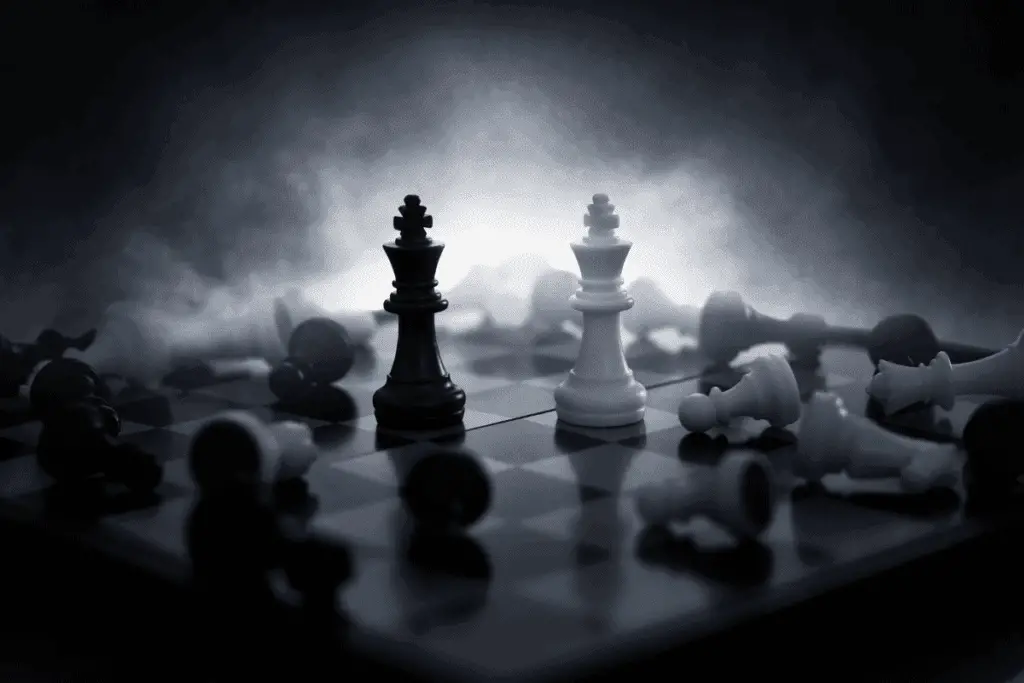
We then assume the rest of the pieces make up the Army protecting the Royal pair, another reasonable assumption, we have the religious presence of the Bishop who was always important in royal courts and council, and of course the trusted Knight on horseback. And of course, those poor Pawns, the infantry leading the charge and being the least important and disposable for a higher cause.
But hang on? What about the rook? Whats a rook in chess? Everything else is of human origin and now we have a bloody Castle that moves around too!!
Let’s take a deeper delve into all chess piece names, the symbolism of individual chess pieces and see how they came to be.
Learn Chess From the Best at a Price you Can Afford
Do you want to be a chess grandmaster?
Even if you don’t have the talent to become the next Garry Kasparov, you can still dramatically improve your chess skills and rating by learning from the Grandmaster himself in 1-2-1 Video lessons. He has over 20 courses to stream that will take you step-by-step to becoming a better player.
By following Garry’s instructions, you will see your ratings soar and be able to beat anyone who dares challenge you!
Learn more about this affordable online chess course now and get started on the path to becoming a grandmaster!
The History of Chess Pieces
There is an in-depth article on ChessQuestions looking back at the history and development of the game of chess over the centuries, but I thought it would be interesting to go a little bit deeper and look at the individual chess pieces, the styles we see today, why they are shaped the way they are and what, if any, symbolism is attached to the way chess pieces look. This post will focus on the shapes and symbolism rather than the history of the pieces themselves.
For instance, The King and Queen are fairly obvious, but are they based on any royalty in particular? And did you have any idea the slit in the top of the Bishop represents the end of an Elephants’s trunk? No, neither did I so I want to look a bit deeper and find out if that is just hearsay or what the story is of how it came to be that way.
What about the difference in style between the pieces of European and Eastern origin? Are they based on any other symbolism that we might not be aware of, or are there more practical reasons for their shapes that you may have never considered?
The article goes through each piece describing its symbolism as well what I learned about how these shapes became popularized over time.
Types of Chess Pieces and What They Represent
There are 6 different pieces in the game of chess. They make up the 16 pieces that you are playing with. A rank of 8 pawns, two each of Bishops, Knights and Rooks, and then the King and Queen.
There is no doubt, that regardless of the origin of chess and the influences on the game as it spread and developed around the world, there is a medieval connotation and connection to true life (At a time) where royalty was the be-all and end-all and had to be protected at all cost (most of the time) – and to hell with the peasants! Defeat the King and the Kingdom shall be mine!
So let’s start with the King and work through the symbolism of chess through the styles and designs of the pieces.
Symbolism in Chess Pieces and What They Represent
Each chess piece represents a character or object in chess. The King and Queen are Royalty Whilst the Bishop is the church. The Knight is a high-ranking fighter or Equine representative, alongside the Pawn-based infantry. The Rook is the Castle Walls or the land!
1. The King is the Leader
The King is the leader of course. He stands the tallest, in most cases, in the chess set and has center stage on the chess board, flanked by his queen and protected by his assembled army, he is limited in movement but can play an integral part of the attack when called upon toward the end game when many of his army and support has fallen by the wayside in battle.

All the time the King remains free and in battle, the game remains active, only should the king be captured [can’t be actually], trapped with inevitable defeat, or resigns a hopeless cause, is the event over. Until the next battle.
2. The Queen Supports with Most Power
The Queen may be the ‘Moon’ – The meaning of the Queen in the game of chess is she is plainly the closest support to the King and if often the second biggest (tallest) piece on the board, signifying her power and importance.
Regardless of the Kings council, the Queen would have the ear of the king and would provide advice. sometimes extending her own will on the people, in a veiled representation of actually more power than the King himself.
She is by far the most fearsome member of the army, able to launch attacks in all directions with pin-point accuracy and is, or at least should be, as fiercely defended as the King. Sending your queen into the attack without the very best of protection and defense can be fateful should be trapped and caught.
You may also have noted that The Queen is the sole feminine representation on the board.
3. The Rook is the Fortress
The Rook Symbolism is based around the name that is often used partially incorrectly for the piece; that being ‘Castle’, Although the term Castle is used when the special move with the King whereby they switch sides is utilized.

The rook is the castle, the walls, the protectorate of the city, and in being so, is the only piece not representative of a living thing. Every country or medieval estate would have its royalty who were protected within the walled city or castle.
4. The Bishop is The Religious Representative
The Bishop represents the church, an important and very powerful entity throughout history and even today if you think about it. Religion was arguably more important during the developing years of the game of chess, and so it stands to reason that it would play a part in the game of life that chess could be deemed to represent. The bishop is a highly placed member of the church and stands to reason they should hold court with royalty and in matters of conflict
5. The Knight Both Attacks, Defends and Jumps
The Knight is on an equal footing with the Bishop and is a represents the very highest rank of medieval military status. Sometimes called the ‘horse‘, you’ll find the Knight almost always represented by a horses head, or in cases, a Knight on horseback in more elaborate sets.
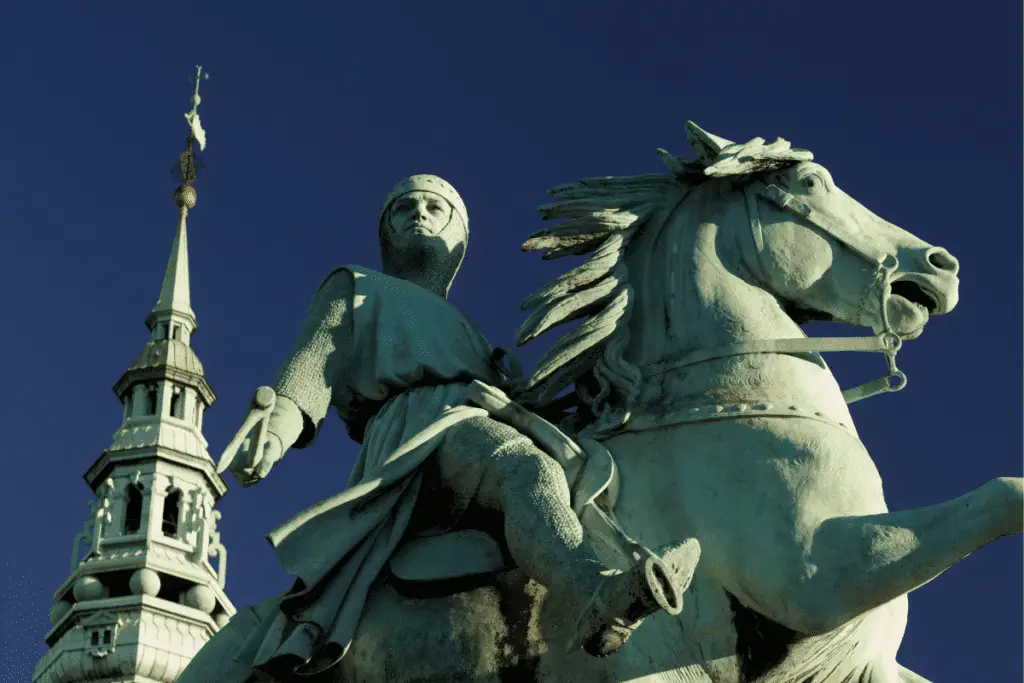
The Knights movement is unique and versatile to a point and it may be no coincidence in symbolism that a horse is able to jump like a knight chess piece can.
6. The Pawns are in Debate, and the First Line of Defence
What is the actual Pawn meaning? It is hard to say. they are certainly cannon fodder for sure, and the first sacrifice you would want to make. So are the pawns serfs, strays, and peasants from outside the city walls – Almost certainly not, this is a trained set of brave soldiers who are the first to face the fight and put their capture on the line in defense of all of the other major pieces on a chessboard.
But they are not purely disposable, as should they find a way to progress to the far ranks of the battlefield and through all opponents, they will sure find promotion to a higher status. Never underestimate the power and importance of a pawn.
They Symbolise the very fabric of the essence of battle, bravery, and sacrifice.
In Closing
Chess Symbolism is as old as the game itself and is said to date back over 1200 years. In chess, all of these shapes have a purposeful meaning or symbolism. And that brings us to the shapes of the pieces and how they are represented in all manner of chess sets we can find in collections the world over, Ancient, Antique, Avant Garde, Art Deco, Contemporary, or bloody BatMan should you so wish for one!
Why Chess Pieces are Shaped the Way they Are – And What They Mean
So let’s take a look at the most traditional of chess sets, and understand why they are shaped the way they are.
Traditionally shaped chess pieces represent the symbolism of each character. Status equals height and general size but the pieces are also designed to be moved by hand which is carefully considered in the design for both comfort and function whilst sitting stably on the board.
For the purpose of this article, I am going to take the world-famous Staunton design and products. It is the most recognizable set of chessmen in the world. If not for the fact that everyone outside of enthusiasts and collectors could identify them as Staunton piece, but if presented to just about any person on the planet and asked what game they came from, the resounding answer in all but very few cases would be “CHESS!”
The King is Tall
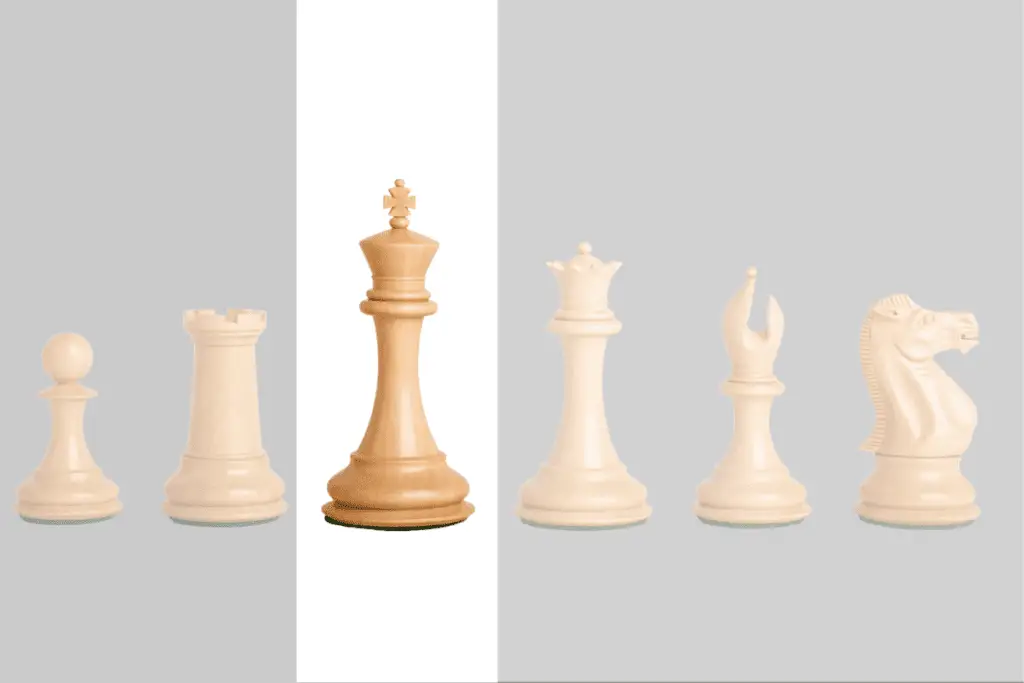
The King Shape meaning in a chess set is designed to be imposing and demonstrate hierarchy. It is most often the tallest piece on the chess board, and will have wide base too.
The King is of a similar size and height to the Queen, but its identifiable difference is the “Finial” represented by a cross slotted into the top of the most valuable piece.
FACT: A finial is an adorning often found the highest part of a building, but can also be found at the end or on corners of objects too.
The Queen wears a Crown
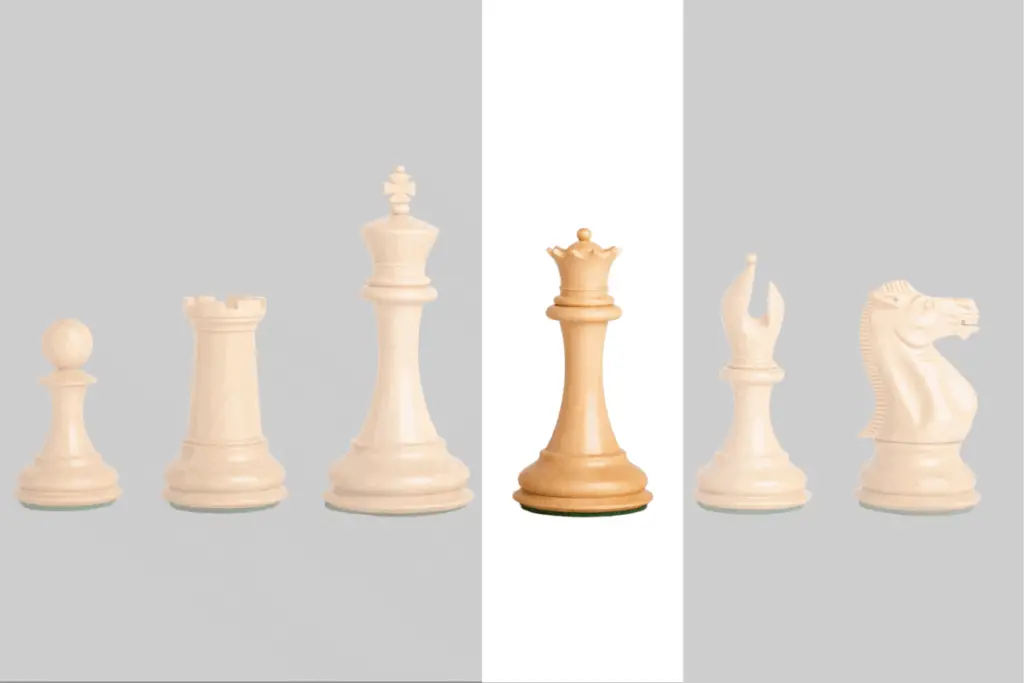
The queen is if similar, shape, size and design to the King in traditional chess sets. Often the shank of the piece will be identical to the king. The distinguishing feature is that she bears an obvious crown. Possibly signifying her covert power over the King
The Rook is the Castle with Turrets
The Rook Shape represents the Castle that is obvious in design. The turrets on top leave you in no doubt. It is a solid piece representing the relative safety of the castle and home.

The Knight is A Grand Horse
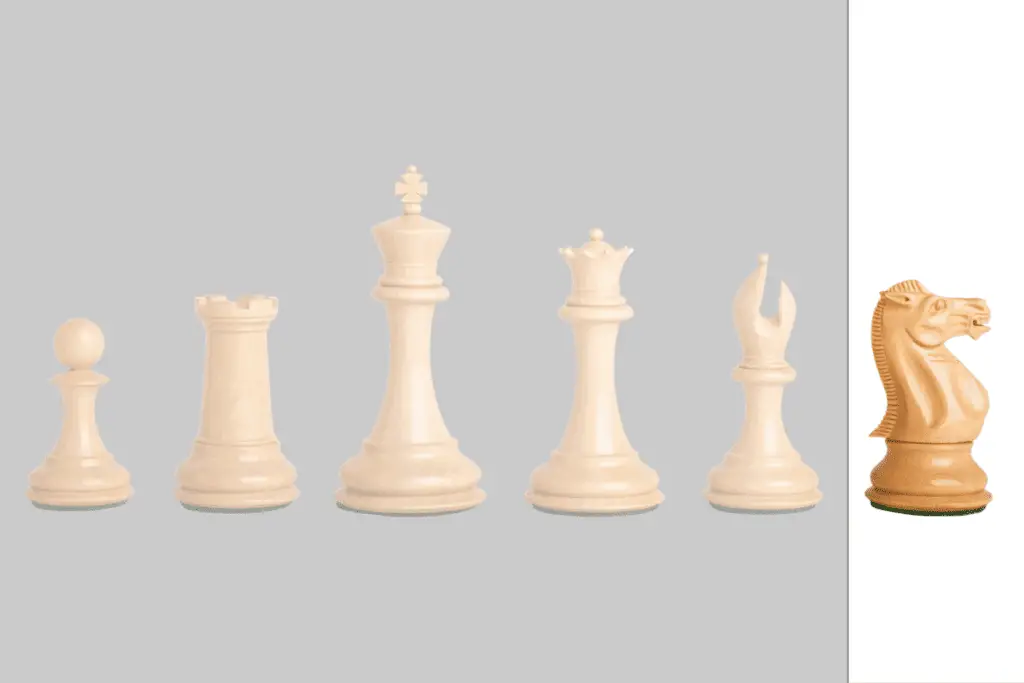
The Knight Shape is plainly that of a horses head. It is not uncommon for the Knight to be known as a horse and it is no wonder with such strong representation. Arguably, the knight is the most elegantly shaped piece in a set of chessmen
The Bishop Wears a Mitre

The shape of the Bishop in Chess is aligned with those of the King and Queen in the sweeping shaft, completing a trio of important human representations. The bishop is slightly shorter though, even given the rather larger headgear of the Christian Bishops Mitre.
You may find claims that the slot in the top of a bishop may have been borne from and is representative of an Elephant’s trunk. Whilst I am not here to deny that, the roots of the development of chess having taken some form in Moorish Spain, and the closeness to the bishop translation of ‘el alfil’, and the Arabic ‘al-fil’ meaning elephant, you can see how evolution may have brought us to where we are now.
Pawn Chess Piece Shape
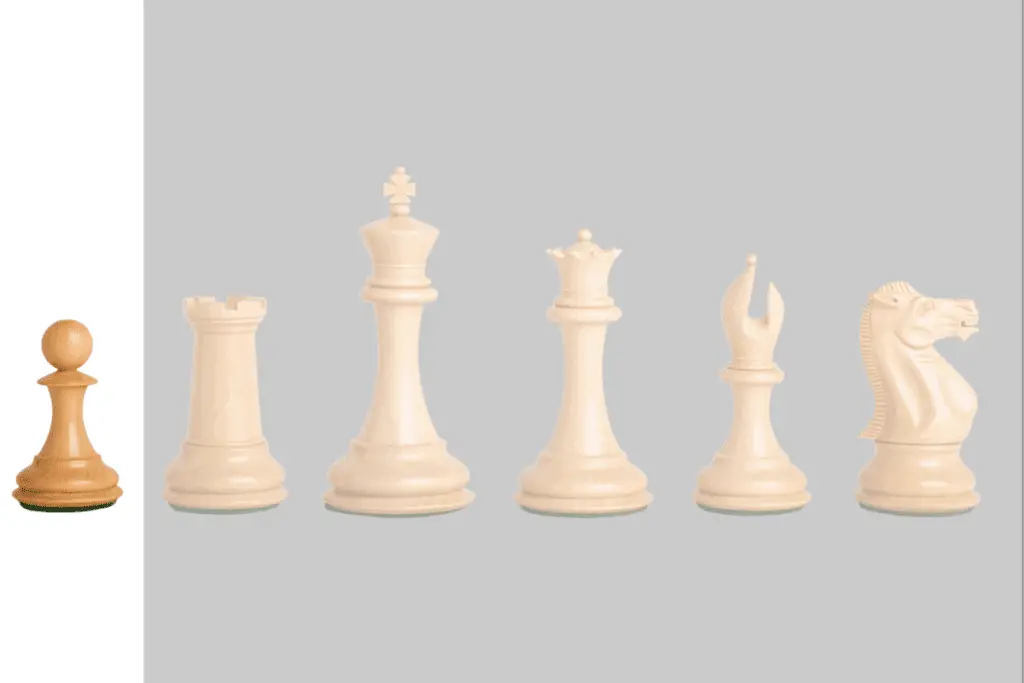
The shape of the pawn in chess represents the lesser value in being the smallest piece in the chessmen set. Although it remains in the sweeping shank style body of both the King and Queen with the small round head[10]
What were Chess Pieces First Made Of?
The earliest known artifacts identifiable as chess pieces were made of Ivory and found in Uzbekistan. Since then, Felt based carved or lathe-turned wooden pieces are common, whilst Stone, Resin and Plastics are used today.
Summary
Regardless of what shape your chessmen are or what they may symbolize, playing a chess game with a great quality chess set of any material is an experience like no other.
ChessQuestions.com is a participant in the Amazon Services LLC Associates Program, an affiliate advertising program designed to provide a means for sites to earn advertising fees by advertising and linking to Amazon.com, Amazon.co.uk or Amazon.ca
You Want to be a BETTER CHESS PLAYER but Don’t Know Where to Start
Everyone knows that chess is a challenging game. Even the best players in the world continue to learn and improve their skills.
Garry Kasparov’s Masterclass Chess Course is the perfect solution for you. In this course, Garry will teach you his favorite openings and advanced tactics, so that you can develop your instincts and philosophy as a chess player. With over 20 hours of video lessons, this course is guaranteed to make you a stronger player.
Alternatively, you can sign up for a Masterclass with Gary Kasparov for just $16 per month. And get access to all other masterclass courses at the same time, from Movie Making, Music recording, Cooking, and Health & Wellbeing.
Chess Set
This is a superb Wegiel Handmade European Ambassador Chess Set which is stored inside the board itself. Super high quality, it looks fantastic too
- Wooden 21 Inch Beech & Birch Board With Felt Base
- Carved Hornbeam & Sycamore Wood Chess Pieces
- Compartment Inside The Board To Store Each Piece
